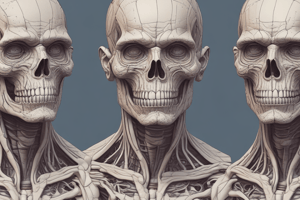Podcast
Questions and Answers
What is the largest bone in the human body?
What is the largest bone in the human body?
- Ulna
- Femur (correct)
- Humerus
- Tibia
Which part of the brain coordinates muscle movements and balance?
Which part of the brain coordinates muscle movements and balance?
- Cerebrum
- Medulla
- Cerebellum (correct)
- Pons
What is the primary function of the alveoli in the lungs?
What is the primary function of the alveoli in the lungs?
- Regulation of breathing
- Exchange of oxygen and carbon dioxide (correct)
- Production of mucus
- Filtration of air
What is the functional unit of the kidney?
What is the functional unit of the kidney?
Which artery supplies blood to the heart muscle?
Which artery supplies blood to the heart muscle?
What hormone regulates the body's metabolic rate?
What hormone regulates the body's metabolic rate?
What is the primary function of red blood cells?
What is the primary function of red blood cells?
Which part of the nervous system is responsible for the 'fight or flight' response?
Which part of the nervous system is responsible for the 'fight or flight' response?
Which of the following bones is located in the upper arm?
Which of the following bones is located in the upper arm?
Which part of the brain is responsible for controlling involuntary actions, such as breathing and heart rate?
Which part of the brain is responsible for controlling involuntary actions, such as breathing and heart rate?
What is the primary function of the walls of the alveoli?
What is the primary function of the walls of the alveoli?
What is the main function of the nephrons in the kidney?
What is the main function of the nephrons in the kidney?
Which artery branches off the aorta to supply blood to the heart muscle?
Which artery branches off the aorta to supply blood to the heart muscle?
What is the primary effect of thyroxine on the body?
What is the primary effect of thyroxine on the body?
What is the primary function of white blood cells?
What is the primary function of white blood cells?
What is the most common way that carbon dioxide is transported in the blood?
What is the most common way that carbon dioxide is transported in the blood?
What is the term for the normal, resting state of the heart rate?
What is the term for the normal, resting state of the heart rate?
Which part of the nervous system is responsible for the 'rest and digest' response?
Which part of the nervous system is responsible for the 'rest and digest' response?
Flashcards are hidden until you start studying
Study Notes
Skeletal System
- The largest bone in the human body is the femur.
Nervous System
- The cerebellum is responsible for coordinating muscle movements and balance.
- The sympathetic nervous system is responsible for the 'fight or flight' response.
Respiratory System
- The main function of alveoli in the lungs is to facilitate the exchange of oxygen and carbon dioxide.
Urinary System
- The nephron is the functional unit of the kidney.
Circulatory System
- The coronary artery supplies blood to the heart muscle.
- The majority of carbon dioxide is transported in the blood as bicarbonate ions.
- A normal resting heart rate for adults is between 60-100 beats per minute.
Endocrine System
- Thyroxine regulates the body's metabolic rate.
Blood
- The primary function of red blood cells is to transport oxygen.
- Carbon dioxide is transported in the blood as bicarbonate ions, dissolved in plasma, and bound to haemoglobin.
Skeletal System
- The largest bone in the human body is the femur.
Nervous System
- The cerebellum is responsible for coordinating muscle movements and balance.
- The sympathetic nervous system is responsible for the 'fight or flight' response.
Respiratory System
- The main function of alveoli in the lungs is to facilitate the exchange of oxygen and carbon dioxide.
Urinary System
- The nephron is the functional unit of the kidney.
Circulatory System
- The coronary artery supplies blood to the heart muscle.
- The majority of carbon dioxide is transported in the blood as bicarbonate ions.
- A normal resting heart rate for adults is between 60-100 beats per minute.
Endocrine System
- Thyroxine regulates the body's metabolic rate.
Blood
- The primary function of red blood cells is to transport oxygen.
- Carbon dioxide is transported in the blood as bicarbonate ions, dissolved in plasma, and bound to haemoglobin.
Studying That Suits You
Use AI to generate personalized quizzes and flashcards to suit your learning preferences.




